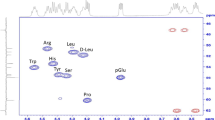Abstract
Synthetic peptides used as therapeutic medicines is continuing to grow as an area of focus within the pharmaceutical industry due to specificity and potency. As such, quality control areas need to continue to advance their capabilities to ensure that appropriate analyses are being performed, and that the data generated are both accurate and precise. One area which poses a significant challenge compared with traditional small molecule drug products is having a highly robust, low variability method of quantifying the assay of the active substance. As many peptide therapeutics are formulated as liquid drug products for injection and preparation procedures to make these samples amenable to traditional chromatographic analysis are inherently low variability (i.e., a simple dilution), potential sources of variance derived from the preparation of the analytical standards used to quantify the assay of the product must be investigated. Here, a fully nested ANOVA experimental design was utilized to examine this process. Such a design allowed for multiple variables to be interrogated as well as the potential interplay of such differences. It was determined that sonication of the standards contributed the most variance, while the balance used and scale on which the standard preparation procedure was performed also contributed significantly. Finally, different procedures for introducing the material into a coulometric Karl Fischer (KF) titration device to quantify the water content of the drug substance were compared and showed that indirect quantification by anhydrous methanol extraction is a significantly more variable method than using an Oven KF autosampler.






Similar content being viewed by others
References
D'Addio SM, Bothe JR, Neri C, Walsh PL, Zhang J, Pierson E, et al. New and evolving techniques for the characterization of peptide therapeutics. J Pharm Sci. 2016;105(10):2989–3006.
Davies M, Pieber TR, Hartoft-Nielsen M-L, Hansen OK, Jabbour S, Rosenstock J. Effect of oral semaglutide compared with placebo and subcutaneous semaglutide on glycemic control in patients with type 2 diabetes: a randomized clinical trial. Jama. 2017;318(15):1460–70.
FDA. FDA approves first oral GLP-1 treatment for type 2 diabetes September 19, 2019 [updated September 20, 2019. Available from: https://www.fda.gov/news-events/press-announcements/fda-approves-first-oral-glp-1-treatment-type-2-diabetes.
Sadrzadeh N, Glembourtt MJ, Stevenson CL. Peptide drug delivery strategies for the treatment of diabetes. J Pharm Sci. 2007;96(8):1925–54.
Muir TW, Dawson PE, Kent SB. [13] Protein synthesis by chemical ligation of unprotected peptides in aqueous solution. Methods in enzymology. 289: Elsevier; 1997. p. 266–98.
de Beukelaar JW, Gratama JW, Smitt PAS, Verjans GM, Kraan J, Luider TM, et al. The impact of impurities in synthetic peptides on the outcome of T-cell stimulation assays. Rapid Communications in Mass Spectrometry: An International Journal Devoted to the Rapid Dissemination of Up-to-the-Minute Research in Mass Spectrometry. 2007;21(7):1282–8.
De Spiegeleer B, Vergote V, Pezeshki A, Peremans K, Burvenich C. Impurity profiling quality control testing of synthetic peptides using liquid chromatography-photodiode array-fluorescence and liquid chromatography-electrospray ionization-mass spectrometry: the obestatin case. Anal Biochem. 2008;376(2):229–34.
Lottenberg R, Christensen U, Jackson CM, Coleman PL. [28] Assay of coagulation proteases using peptide chromogenic and fluorogenic substrates. Methods in enzymology. 80: Elsevier; 1981. p. 341–61.
Lin ZJ, Li W, Weng N. Capsule review on bioanalytical method transfer: opportunities and challenges for chromatographic methods. Bioanalysis. 2011;3(1):57–66.
Bronsema KJ, Bischoff R, van de Merbel NC. Internal standards in the quantitative determination of protein biopharmaceuticals using liquid chromatography coupled to mass spectrometry. J Chromatogr B. 2012;893:1–14.
Wren SA, Tchelitcheff P. Use of ultra-performance liquid chromatography in pharmaceutical development. J Chromatogr A. 2006;1119(1–2):140–6.
Girden ER. ANOVA: repeated measures: Sage; 1992.
St L, Wold S. Analysis of variance (ANOVA). Elsevier; 1989. p. 259–272.
Webster R, Oliver M. Nested sampling and analysis. Oxford University Press, New York, USA; 1990.
Vander Heyden Y, De Braekeleer K, Zhu Y, Roets E, Hoogmartens J, De Beer J, et al. Nested designs in ruggedness testing. Elsevier; 1999. p. 875–887.
Candolfi A, Massart DL, Heuerding S. Investigation of sources of variance which contribute to NIR-spectroscopic measurement of pharmaceutical formulations. Elsevier; 1997. p. 185–196.
Parra MG-d, Rodriguez-Loaiza P. Application of analysis of means (ANOM) to nested designs for improving the visualization and understanding of the sources of variation of chemical and pharmaceutical processes. Taylor & Francis. 2003:663–70.
Bruttel P, Schlink R. Water determination by Karl Fischer titration. Metrohm monograph. 2003;8(026):50003.
Toledo M. Microbalance Products and Specs. Accessed on October 18, 2019. [Available from: https://www.mt.com/us/en/home/products/Laboratory_Weighing_Solutions/Micro_Ultra_Balances/XPR_MicroBalance.html#models-and-specs].
Toledo M. Analytical Balance Products and Specs. Accessed on October 18, 2019. [Available from: https://www.mt.com/us/en/home/products/Laboratory_Weighing_Solutions/Analytical/Excellence/xpr-analytical-balances.html#models-and-specs].
Stathopulos PB, Scholz GA, Hwang YM, Rumfeldt JAO, Lepock JR, Meiering EM. Sonication of proteins causes formation of aggregates that resemble amyloid. Wiley Online Library; 2004. p. 3017-27.
Wang X, Kluge JA, Leisk GG, Kaplan DL. Sonication-induced gelation of silk fibroin for cell encapsulation. Biomaterials. 2008;29(8):1054–64.
Manning MC, Chou DK, Murphy BM, Payne RW, Katayama DS. Stability of protein pharmaceuticals: an update. Pharm Res. 2010;27(4):544–75.
Torosantucci R, Schöneich C, Jiskoot W. Oxidation of therapeutic proteins and peptides: structural and biological consequences. Pharm Res. 2014;31(3):541–53.
Patel J, Kothari R, Tunga R, Ritter N, Tunga B. Stability considerations for biopharmaceuticals: overview of protein and peptide degradation pathways. BioProcess International. 2011;9:2–11.
Huynh-Ba K. Handbook of stability testing in pharmaceutical development: regulations, methodologies, and best practices: Springer Science & Business Media; 2008.
Acknowledgments
The authors would like to thank Jameson Bothe, Alexandra Esposito, and Justin Pennington for their helpful conversations and suggestions.
Author information
Authors and Affiliations
Corresponding author
Ethics declarations
Conflict of Interest
The authors declare that they have no conflict of interest.
Additional information
Publisher’s Note
Springer Nature remains neutral with regard to jurisdictional claims in published maps and institutional affiliations.
Rights and permissions
About this article
Cite this article
Walsh, P.L., Lena, J., Drake, J. et al. Determining the Sources of Variance in the Preparation of Analytical Standards for Chromatographic Analysis of a Lyophilized Peptide Drug Substance by Nested ANOVA Statistical Analysis. AAPS PharmSciTech 21, 70 (2020). https://doi.org/10.1208/s12249-020-1623-5
Received:
Accepted:
Published:
DOI: https://doi.org/10.1208/s12249-020-1623-5




